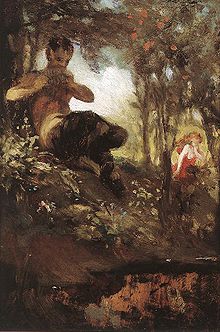
Back فون (أسطورة) Arabic Favn Azerbaijani Фаўн Byelorussian Фавн Bulgarian Faune Catalan Faun Czech Faun Danish Faŭno (mitologio) Esperanto Fauno Spanish Faunid Estonian


The faun (Latin: Faunus, pronounced [ˈfäu̯nʊs̠]; Ancient Greek: φαῦνος, romanized: phaûnos, pronounced [pʰâu̯nos]) is a half-human and half-goat mythological creature appearing in Greek and Roman mythology.
Originally fauns of Roman mythology were ghosts (genii) of rustic places, lesser versions of their chief, the god Faunus. Before their conflation with Greek satyrs, they and Faunus were represented as naked men (e.g. the Barberini Faun). Later fauns became copies of the satyrs of Greek mythology, who themselves were originally shown as part-horse rather than part-goat.
By the Renaissance, fauns were depicted as two-footed creatures with the horns, legs, and tail of a goat and the head, torso, and arms of a human; they are often depicted with pointed ears. These late-form mythological creatures borrowed their look from the satyrs, who in turn borrowed their look from the god Pan of the Greek pantheon. They were symbols of peace and fertility, and their Greek chieftain, Silenus, was a minor deity of Greek mythology.[1]
- ^ Canadian Oxford Dictionary (2nd ed.). Oxford University Press. 2004. p. 541.